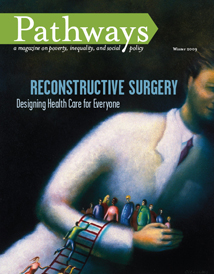Reconstructive Surgery

Designing health care for everyone: How do we get there?
Table of Contents (Winter 2009)
EDITOR'S NOTE
Intervention
The Earned Income Tax Credit is widely cited as one of America's most successful antipoverty programs. But can it be improved? Retooled for the economic crisis? Gordon Berlin describes how a refashioned EITC could make poverty history.
RECONSTRUCTIVE SURGERY: DESIGNING HEALTH CARE FOR EVERYONE
Jonathan Gruber argues for a two-tier health system that has government mandated minimum standards for coverage, access, and quality but allows individuals to buy more than that minimum.
Karen Davis and Kristof Stremikis lay out a five-pronged strategy for eliminating health inequality that is built around the concept of a patient-centered medical home.
Robert E. Moffit calls for a fundamental revamping of the health care system in which access to insurance no longer depends on employment.
Barbara L. Wolfe suggests that headway on disparities is best made by targeting the health of low-income women and their children.
Research in Brief
The three countries with the most successful poverty-fighting strategies, the rise of a new Republican populism, the effect of female-friendly labor markets on the gender gap in math, and other cutting-edge research.
Trends
Consumer debt is skyrocketing. Is there any way to pay it off? Or is the American consumer going down? Teresa A. Sullivan explains why the bailout must be extended to American families.
